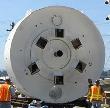 The Original Monorail:
The Original Monorail:Starting in April of 1961, the Alweg Seattle Center Monorail was built in only ten months. The Monorail opened in March of 1962, and with a system cost of $3.5 million, paid for itself with the fares of eight million passengers during the Seattle World's Fair. To this day, because it connects two major pedestrian centers in Seattle's urban core, it is the only transit system in the country to fund its own operation from fare recovery. It operates at a maximum of 50 miles per hour, and carries 2.5 million passengers per year - filling up during Seattle Center events like Bumbershoot, Folklife, and the Bite of Seattle, as well as sporting events and concerts at Key Arena.
Initiative 41:As a result of the original monorail, Seattle has had a love affair with the technology for decades. Several proposals have been made since the World's Fair to expand the existing monorail, but none made it to the ballot until Dick Falkenbury, a taxi driver with a dream of better public transit,
brought us Initiative 41 in 1997.
The initiative incorporated a public agency called the Elevated Transportation Company (ETC) and called for the construction of a 40 mile system, referred to often as a "Big X." The system was to connect West Seattle to Lake City with one 20 mile line, and the Rainier valley to Broadview with the other. This plan was brought forward with the assurance of the grassroots campaign behind it that it would pay for itself - in fact, that private developers would build the line without taxpayer dollars because, like the Seattle Center Monorail, it would pay for its own construction costs within only a few years.
The plans in Initiative 41 were specific: The system would run on rubber tires and electricity, would have set station locations (including one at the Kingdome), and would not be publicly funded - although the twist of phrase that may have later saved the ETC allowed them, nonetheless, to appropriate public funds from the City Council. The proposed 12 ETC Councilmembers were to be appointed by an even split of the Mayor, the Governor, and the President of the City Council. The City Council was also given the authority to approve or deny expenses and salaries to be drawn by the ETC Council.
Funding dries up:In 1998 following the passage of I-41, the City Council created the ETC and gave it $200,000 to explore the idea of the monorail system. While that money was only intended for the first year of operation, it lasted until 2000, when the ETC went to Sound Transit to ask for $50,000 (to be matched by the City Council) to study ridership of a 7 mile system to connect the new stadia and the Seattle Center. Sound Transit's three member finance committee, including Greg Nickels, approved the plan. The Sound Transit executive committee
denied the grant by a vote of 6 to 3, despite a 1999 resolution by the ETC that they would not attempt to compete with Sound Transit along their planned light rail alignment.
Mayor Paul Schell and City Councilmember Richard McIver were part of that 6, and backed up their position (and the City Council's) with two major arguments: First, the ETC had raised only $5500 in private funds since their incorporation. It was not clear that private funding for the project would occur, and that was part of the company's charter. Second, the study was for ridership along the route only, not an evaluation of technology, and the City of Seattle
Intermediate Capacity Transit Project (ICT) was already to complete the same goals by that fall. The ETC responded to this setback with
a request to the Mayor and City Council for $2 million, $1.7 million of which was earmarked to fund the study. Because of the elimination of the Motor Vehicle Excise Tax (MVET) due to Initiative 695, Metro Transit already needed a $120 million sales tax increase to continue operations, and the Mayor's office declined the request.
The City Council gets involved:
In May, while ETC had less than $20,000 left, City Councilmembers Nick Licata and Judy Nicastro proposed a $4 million study along the lines of ETC's resolution - to explore service on alignments Sound Transit did not plan to serve with intermediate or high capacity transit. Citing an estimated cost of the monorail line at up to $50 million a mile, McIver and three other councilmembers argued successfully in a 4-4 vote that with a $200 million parks levy and Metro funding already on the ballot, it was unreasonable to ask for more money from voters. A superior court ruling, however, woke up the City Council to the reality of that twist of phrase in Article IV of Initiative 41.
The ruling gave the Council two options: Move forward with the monorail using public funds, or repeal the initiative.
In July, the Seattle City Council
amended the initiative to effectively repeal it, creating an advisory committee named the Elevated Transportation Committee to enhance the ICT study to see how monorail would fit into overall transportation plans. The Council discussed putting a vote on the primary ballot for that year to let voters choose to pay for the line with a property tax increase of $570 to $1141 a year, but eventually
chose not to in another 4-4 vote.
Initiative 53:
While the City Council remained indecisive, Peter Sherwin was at work
gathering signatures and public support for an initiative. It would fund a $6 million feasibility study to determine the effectiveness of monorail for the five ICT corridors, and guarantee $200 million in debt for the Committee to use to construct the system. I-53
qualified for the November ballot and passed, and the ETC met again at the end of 2000.









